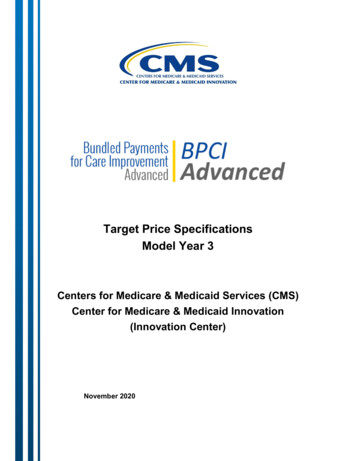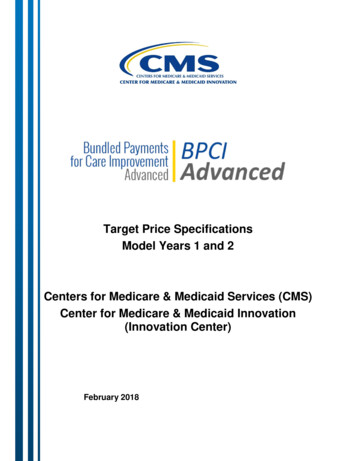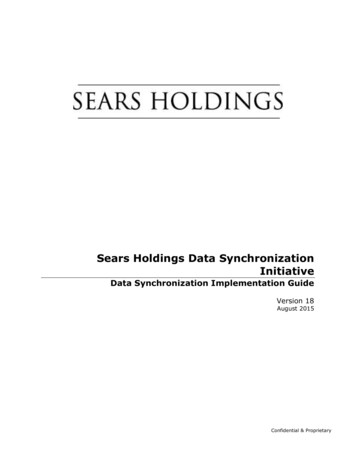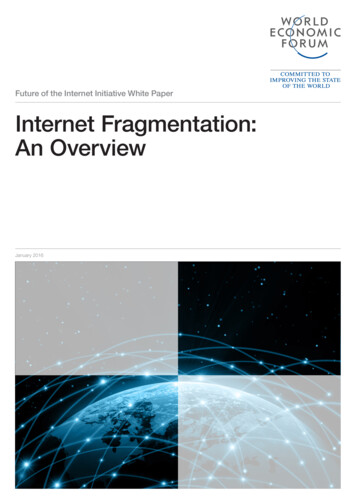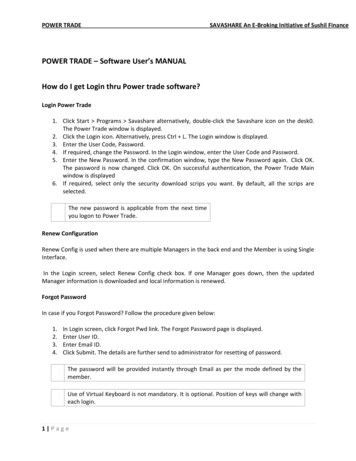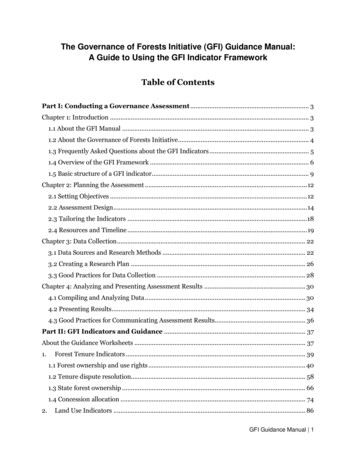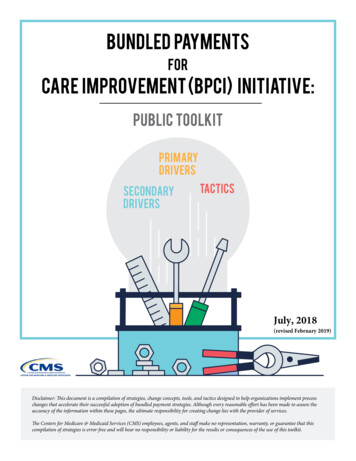
Transcription
Bundled PaymentsforCare Improvement (BPCI) initiative:public toolkitPRIMARYDRIVERSSECONDARYDRIVERStacticsJuly, 2018(revised February 2019)Disclaimer: This document is a compilation of strategies, change concepts, tools, and tactics designed to help organizations implement processchanges that accelerate their successful adoption of bundled payment strategies. Although every reasonable effort has been made to assure theaccuracy of the information within these pages, the ultimate responsibility for creating change lies with the provider of services.The Centers for Medicare & Medicaid Services (CMS) employees, agents, and staff make no representation, warranty, or guarantee that thiscompilation of strategies is error-free and will bear no responsibility or liability for the results or consequences of the use of this toolkit.
IntroductionThe Bundled Payments for Care Improvement (BPCI) Initiative, established in 2013, was one of the first CMSInnovation Center episode-based payment model tests. During participation in this bundled payment model,participant organizations, referred to as Awardees, use various strategies to provide Medicare beneficiarieswith coordinated, higher quality care at lower costs. Unlike the fee-for-service model which reinforces silos,bundled payments for all services in an episode of care are linked, leading to greater financial and performanceaccountability. Incentives for “hospitals, post-acute care providers, physicians, and other practitioners” are aligned,encouraging collaboration across all settings.1Recognizing that there is no single pathway to success as a BPCI organization, the CMS Innovation Centercontracts with The Lewin Group, for the BCPI Learning System, to harvest these strategies and disseminate ideas.This toolkit compiles strategies, processes, and resources from the CMS Innovation Center BPCI Learning Systemto help BPCI organizations identify new insights that may aid them in their implementation of bundled paymentstrategies.Research suggests that there are many “ingredients to success,” or factors, that drive strong performance in ClinicalEpisode Bundles. A driver diagram, also referred to as a logic model, depicts how different “drivers,” or coreactivities, come together to help an organization achieve its objectives. In the BPCI toolkit, the primary drivers,comprised of seven focus areas, provide a high-level plan to meet the overall goals of BPCI. Underlying eachprimary driver are secondary drivers that represent core activities to implement the primary drivers. Finally, thesedrivers are grounded by specific tactics that any organization can begin testing in a controlled environment to seeif they result in meeting the goals of improved quality at lower costs.Page 3 of this toolkit shows the primary and secondary drivers for success in bundled payments. Primary driversand their associated secondary drivers and tactics may not be linear. Each organization may use various driversand tactics at different times based on the episode, local community needs, and patient populations. Organizationsare not expected to —nor should they—implement all the tactics.To develop the toolkit, 35 high performing Awardees were identified for interviews based on select quality,utilization, and cost metrics. The analytical plan for identifying top performers was adapted from the AchievableBenchmarks of Care (ABC) method, first proposed by Kiefe and colleagues (1998).2 The ABC method doesnot seek to measure the statistical significance of observed differences between Awardees. Because the intentis non-evaluative, it is not critically important to know whether an observed difference between an Awardee’sperformance and the benchmark is statistically significant. Rather, ABCs are targets for process measurement,where the measures of the use of “best practices of care” by Awardees are the same across sites. The Awardeeinterviews followed a set of standard questions, and allowed for open dialogue to discuss key drivers and tacticsthat Awardees believed were instrumental to their success.The toolkit also includes a variety of tools and resources that organizations use and those identified from peerreviewed and grey literature. Examples of Awardees’ successful BPCI strategies for select episodes, in the formof short case studies, called Awardee Spotlights, can be found at the end of the toolkit. Strategies highlightedin these Awardee Spotlights correspond to several primary and secondary drivers, illustrating how they can beimplemented in practice.1Centers for Medicare & Medicaid Services. (2018, February 16). Bundled Payments for Care Improvement (BPCI) Initiative: General Information.2Kiefe CI, Weissmaqn NW, Allison JJ, Farmer RM, Weaver M, Williams OD. Identifying achievable benchmarks of care (ABCs):concepts and methodology. International Journal for Quality in Health Care. 1998 Oct: 10(5): 443-7.2
BPCI Driver DIAGRAMAIMS: IMPROVE QUALITY OF CARE, IMPROVE HEALTH OUTCOMES, & REDUCE COST OF CAREPRIMARY DRIVERSpage 4Strategic partnershipsto promote carecoordination anddata sharingpage 6Efficient andappropriate staffingmodelspage 9Patient identificationand risk stratificationpage 11Effective clinical andfinancial managementsecondary DRIVERS Promote collaboration and coordination betweenhospitals, clinicians, and other care settings forsmooth patient transition Involve multidisciplinary teams in the ideageneration and decision-making processProvide a learning and communication platform forclinicians and internal staffOffer standardized education to staffDesignate an individual to follow the patientthroughout the episode and be the point person forcommunications with all providers included in thepatient’s care team page 12Patient and familyengagementthroughout thecare continuum page 14Data driven programmanagement Optimize strategy for effective clinical managementof careUse technology to identify and monitor patientsCare redesign/use of evidence-informed careprotocolsIdentify internal cost saving opportunities andimplement financial incentivesCommunicate and engage with providers, patient,and family throughout the episode by providingongoing care and supportCreate touchpoints throughout the care continuumto engage the patient and prevent avoidablereadmissionsEngage patient and family through education andshared decision-making in discharge planning andplacement decisions to support patient rights andpreferencesCollect and analyze process and outcome data totrack progress toward quality improvementUse data to engage providers, monitor progresstowards goals, and improve care strategiesMake data actionable and transparentCreate lean quality improvement strategy that can beconstantly tested and improvedConnect with colleagues, both locally and nationally,to share best practices and resourcespage 16Continuous qualityimprovementpage 17BPCI Awardee Spotlightpage 32Appendix: Additional Resources 3
STRATEGIC PARTNERSHIPS TOPROMOTE CARE COORDINATIONAND DATA SHARINGLITERATURE: OhioHealth ‘saved about 250 lives’ by reducing its sepsis mortality rate. Here’s how. Hospital Postacute Care Referral Networks: Is Referral Concentration Associated with Medicare-StyleBundled Payments? How to Succeed in Bundled Payments for Total Joint Replacement Association Between Hospital Participation in a Medicare Bundled Payment Initiative and Payments andQuality Outcomes for Lower Extremity Joint Replacement EpisodesSECONDARYDRIVERPromote collaboration and coordination between hospitals, clinicians,and other care settings for smooth patient transition.TACTICSHold regular meetings with key stakeholders—including inpatient providers and post-acutecare (PAC) providers—to ensure smooth transitions of care, identify best practices in caremanagement, and share successes in improving quality of care and reducing costs.Create a “preferred provider” network by implementing and enforcing a set of standards thatacute and PAC providers must meet in order to receive referrals or be eligible for gainsharing.Create and foster partnerships with PAC providers in the community, including institutionalcare providers, home care and home health providers, and care transitions programs.Partner with a local fire department and/or paramedicine to have emergency medical servicesstaff visit patients in their homes.Establish a partnership with local pharmacies that may be able to provide free or low-costmedications to patients that have limited financial resources.4
STRATEGIC PARTNERSHIPS TO PROMOTE CARE COORDINATION AND DATA SHARINGPromote collaboration and coordination between hospitals, clinicians, and other care settings for smooth patient transition.Create and deliver staff education regarding targeted conditions and their treatment to ensurestandardized care protocols are understood and followed, and that the message is consistentamong staff.Share the comprehensive summary of the patient’s care with acute and PAC providers.Utilize data analytics to analyze claims data for clinical episodes and assist with care redesignand care coordination.5
EFFICIENT AND APPROPRIATESTAFFING MODELSLITERATURE: Cost of Joint Replacement Using Bundled Payment Models Experience with Designing and Implementing a Bundled Payment Program for Total Hip Replacement How UCHealth reduced sepsis mortality by 15 percent OhioHealth ‘saved about 250 lives’ by reducing its sepsis mortality rate. Here’s how. How to Succeed in Bundled Payments for Total Joint Replacement Bundled payment success varies by conditionSECONDARYDRIVERInvolve multidisciplinary teams in the idea generation and decisionmaking process.TACTICSInvolve physicians as part of the multidisciplinary team to make collaborativedecisions regarding care pathways, resources, and supply use (e.g., standardimplant use for total joint replacement procedures).Conduct multidisciplinary clinical team rounds (e.g., surgeons, nurses, anesthesiologists,physical therapists, case management, care navigators, pharmacists) to facilitate sharing ofinformation and address issues as they are identified in real-time.Deploy a rapid response team (e.g., intensive care unit nurse, lab technician, respiratorytherapist, intensivist physician, care coordinator) for select high-risk clinical conditions (e.g.sepsis).Involve a pharmacist to conduct medication teaching and to conduct bedsidemedication teaching prior to discharge to review their medications.6
EFFICIENT AND APPROPRIATE STAFFING MODELSSECONDARYDRIVERProvide a learning and communication platform for clinicians andinternal staff.TACTICSDevelop clinical steering committees or workgroups to determine best practices, establishprotocols for change, and define relevant metrics to measure impact. Encourage teams to meeton a regular basis (e.g., daily, bi-weekly, monthly, quarterly) to maintain communication andsustain engagement in important initiatives.Establish a process that enables emergency department (ED) staff to communicate with floorstaff about urgent matters.Garner the support of a “physician champion,” whom other providers listen to and trust(e.g., a clinical peer, department chair) and have them demonstrate their support for qualityimprovement initiatives.Promote a culture of peer-review, where members of the care team (e.g., physicians, casemanagement, quality teams) receive data driven feedback from their colleagues and areprovided additional education if needed.Create or hire “care coordination staff ” that follow up directly with providers in the hospital,home health agencies (HHAs), and skilled nursing facilities (SNFs) to ensure smooth patienttransitions and discharges.SECONDARYDRIVEROffer standardized education to staff.TACTICSCreate and deliver staff education regarding targeted conditions and their treatment to ensurestandardized care protocols are understood and followed, and that the message is consistentamong staff.Develop pocket cards for physicians and nurses for standardized care protocols for targetedconditions.7
EFFICIENT AND APPROPRIATE STAFFING MODELSSECONDARYDRIVERDesignate an individual to follow the patient throughout the episodeand be the point person for communications with all providersincluded in the patient’s care team.TACTICHire a care/patient navigator, care coordinator, or transitional care specialist.8
PATIENT IDENTIFICATIONAND RISK STRATIFICATIONLITERATURE: Improvement in Total Joint Replacement Quality Metrics: Year One Versus Year Three of the BundledPayments for Care Improvement Initiative Physicians With Defined Clear Care Pathways Have Better Discharge Disposition and Lower CostSECONDARYDRIVEROptimize strategy for effective clinical management of care.TACTICSUse a risk assessment tool to tailor the care plan (e.g. number of follow-up calls, level ofclinician interaction, referrals to services) for patients.Develop a protocol to standardize processes for pre-, intra-, and post-operative phases (e.g.,risk assessments, rounding frequency, early ambulation, initiation of discharge process,transfer of medication information).SECONDARYDRIVERUse technology to identify and monitor patients.TACTICSFlag BPCI patients in electronic health record (EHR) system when they are seen in the ED oradmitted to the hospital.9
PATIENT IDENTIFICATION AND RISK STRATIFICATIONUse technology to identify and monitor patients.Build logic into EHR to issue an alert if a patient illustrates a specific set of criteria. Deploya charge nurse, nurse supervisor, or the coordinator to the bedside of the patient exhibitingthese symptoms. Simplify the set of criteria whenever possible.Use technology to monitor the patient after discharge (e.g. vital statistics such as weight, heartrate, blood pressure, and oxygen levels; use of telehealth technology for virtual visits).10
EFFECTIVE CLINICAL ANDFINANCIAL MANAGEMENTSECONDARYDRIVERCare redesign/use of evidence-informed care protocols.TACTICSManage pre-existing chronic conditions.Standardize patient care by developing and deploying protocols and carepathways (e.g., initiate “Code Sepsis”)Expand successful care redesign strategies to include non-BPCI patients.SECONDARYDRIVERIdentify internal cost saving opportunities and implementfinancial incentives.TACTICSIdentify supply chain improvement opportunities and negotiate with vendors.Use CMS resources and waiver authority to improve coordination of care throughoutthe episode, such as beneficiary incentive and three-day SNF waiver.Reward clinicians for improved outcomes, such as through gainsharing.Invest in ongoing infrastructure enhancements (including IT and communicationinfrastructure).11
PATIENT AND FAMILY ENGAGEMENTTHROUGHOUT THE CARE CONTINUUMLITERATURE: Improvement in Total Joint Replacement Quality Metrics: Year One Versus Year Three of the BundledPayments for Care Improvement InitiativeSECONDARYDRIVERCommunicate and engage with providers, patient, and familythroughout the episode by providing ongoing care and support.TACTICSEstablish a process for providers to follow up with the patient during post-dischargeperiod.Enable real-time sharing of patient information between providers and patients.SECONDARYDRIVERCreate touchpoints throughout the care continuum to engage thepatient and prevent avoidable readmissions.TACTICSDevelop a protocol to follow up with patients during the post-discharge period, such asthrough the use of a care coordinator/navigator or by creating designated touchpoints.Use data tracking services and technologies, such as software that allows for video callcapabilities between provider and patient and tracks information gathered during postdischarge follow-up calls and visits.12
PATIENT AND FAMILY ENGAGEMENT THROUGHOUT THE CARE CONTINUUMCreate touchpoints throughout the care continuum to engage the patient and prevent avoidable readmissions.Implement the use of a patient portal to provide patients access to care plan and data.Prior to a surgery or procedure, identify a family member or caregiver who will be ableto provide support to the patient at home post-discharge.Use technology to monitor the patient after discharge (e.g. vital statistics such as weight,heart rate, blood pressure, and oxygen levels; use of telehealth technology for virtualvisits).SECONDARYDRIVEREngage patient and family through education and shareddecision-making in discharge planning and placement decisionsto respect patient rights and preferences.TACTICSEducate and engage patients in self-care while respecting patient choice. Offer preeducation courses to discuss procedure, plan of care, and PAC. If patient/family isnot able to or is uninterested in attending a pre-surgical education class, provide thematerials online or send paper materials through the mail.Set expectations upfront and inform patients of their options for PAC, includingthe identified benefits of preferred providers and partners.Ensure that the clinical team and the patient/family coordinate to develop a post-acutedischarge plan. Understand what is important to the patient and their family to supportshared decision-making, while providing them with the necessary information to makean informed decision (e.g., to discharge to an institutional PAC facility, home withhome health care).Use beneficiary incentives to support patients (e.g., providing transportation).Designate patient volunteers to help with the development of educational materials,programs, or classes.13
DATA DRIVEN PROGRAMMANAGEMENTLITERATURE: Transitioning From Volume to Value: A Strategic Approach to Design and Implementation Experience with Designing and Implementing a Bundled Payment Program for Total Hip ReplacementSECONDARYDRIVERCollect and analyze process and outcome data to track progresstoward quality improvement.TACTICSAssess and build organizational capacity to track and review performance on qualitymeasures in as real-time as possible (e.g., daily reports).Ensure all relevant stakeholders are involved in the metric selection and assessmentprocess.Consider collecting a combination of quantitative data (e.g., claims, surveys, costs) andqualitative data (e.g., interviews, observations, document analysis) to understand what ishappening, why it is happening, and what impact it is having.Track process and outcome measures at both the individual provider and grouplevel, depending on what seems most appropriate for a given measure.14
DATA DRIVEN PROGRAM MANAGEMENTSECONDARYDRIVERUse data to engage providers, monitor progress towards goals,and improve care strategies.TACTICSDevelop a mechanism to regularly disseminate results to relevant stakeholders to informquality efforts, programs, and policies.Use performance improvement tools such as dashboards, scorecards, and the PlanDo-Study-Act (PDSA) methodology to communicate data to executive leadership,physicians, and other providers as a way to promote change and ultimately improvepatient care processes and outcomes.Customize metrics and dashboards for target audiences (e.g., anesthesia, surgery,cardiology, inpatient, PAC providers, administrative, financial) so that the informationis most relevant to them.Share data to highlight data trends over time (e.g., length of stay, readmissions, clinicaloutcomes, discharge disposition) for preferred providers.SECONDARYDRIVERMake data actionable and transparent.TACTICSUse data to set specific performance expectations for providers using quality measures(e.g., use quality measures to initiate conversations about variations between referralpatterns and the outcomes obtained from use of predictive tools, use quality measuresto compare patient outcomes with different PACs).Share performance data transparently (unblinded) across providers and/or facilitiesto facilitate open and honest dialogue about best practices, and promote a sense ofcollegial competition.15
CONTINUOUS QUALITYIMPROVEMENTSECONDARYDRIVERCreate lean quality improvement strategy that can be constantly testedand improved.
Hire a care/patient navigator, care coordinator, or transitional care specialist. 9. PATIENT IDENTIFICATION AND RISK STRATIFICATION. . Build logic into EHR to issue an alert if a patient illustrates a specific set of criteria. Deploy a charge nurse, nurse supervisor, or the coordinator to the bedside of the patient exhibiting .
